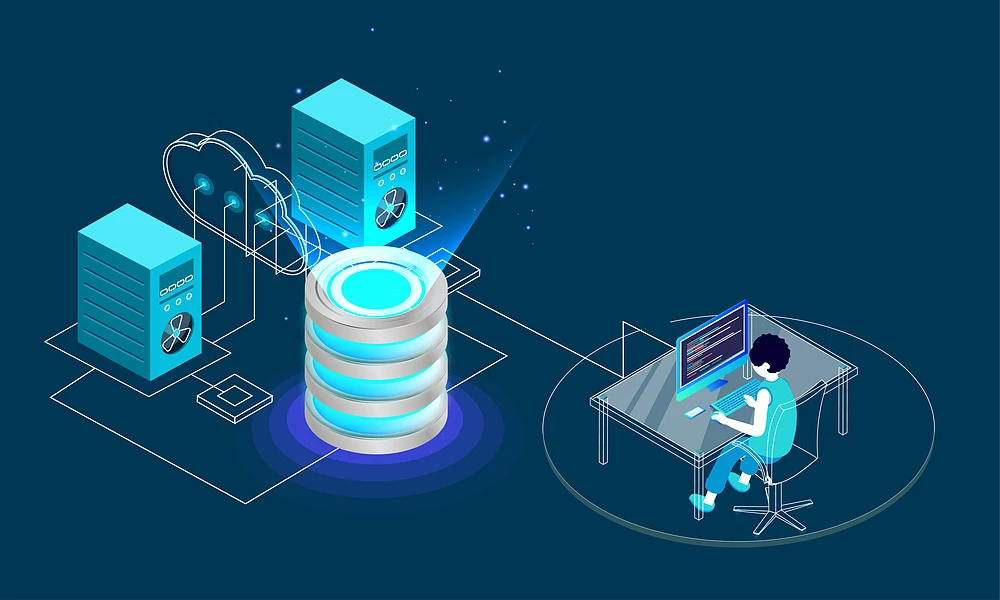The most common way to connect frontend to backend is by using RESTful API communication. Other processes of connecting frontend to backend include using web socket communication, server-side rendering (SSR), GraphQL integration or combining WebSockets and GraphQL.
There are 5 known ways to connect frontend and backend applications, they include:
#Process 1: Connecting Frontend and Backend using RESTful API Communication
#Process 2: Connecting frontend and Backend using Web Socket Communication
#Process 3: connecting Frontend and Backend using Server Side Rendering (SSR)
#Process 4: Connecting Frontend and Backend using GraphQL Integration
#Process 5: Connecting Frontend and Backend by combining WebSockets and GraphQL
In this article, we are going to break down all 5 processes to fully understand how each one works.
Toward the end of this article, I’ll take you through a practical example of connecting the frontend to the backend using the most common method: RESTful API communication.
For this example, we’ll assume a simple scenario of managing a collection of books as we aim to link both the frontend and backend of the bookstore as well as interacting with the backend API.
So feel relaxed, as this will be a detailed guide.
Without any further ado, let’s get started.
#PROCESS 1: Connecting Frontend and Backend using RESTful API Communication
RESTful API Communication: Representational State Transfer (REST) is a popular architectural style for building web services.
It utilizes the HTTP protocol for communication between the frontend and backend.
Before we dive deep into “RESTful API Communications”, let’s first understand some key connection terms.
API: This means Application Programming Interface, it defines a set of rules and protocols that allow different software applications to communicate with each other.
HTTP (Hypertext Transfer Protocol): HTTP is the protocol used for transferring data over the web. It enables communication between clients (such as browsers) and servers.
Endpoints: Endpoints are URLs that represent specific resources on the server.
In RESTful APIs, endpoints are used to perform different actions (e.g., retrieving data, creating new records, updating existing records, deleting records).
HTTP Methods: RESTful APIs utilize different HTTP methods for different types of operations:
- GET: Retrieve data from the server.
- POST: Send data to the server to create new records.
- PUT: Update existing records on the server.
- DELETE: Remove records from the server.
We now understand the meaning of API, HTTP, Endpoints, HTTP Methods and REST.
Let’s now talk about the steps required to connect frontend and backend using RESTful API
STEP 1: Setting Up the Backend API
- Choose a backend framework or technology such as Node.js with Express or Django for Python.
- Define routes and endpoints for your API using the chosen framework.
- Implement business logic and database operations within the API endpoints.
STEP 2: Sending Requests from the Frontend
- Use JavaScript’s fetch API or libraries like Axios to send HTTP requests from the frontend.
- Construct the appropriate request method (GET, POST, PUT, DELETE) and headers.
- Include any necessary data in the request body or as query parameters.
STEP 3: Handling Responses in the Frontend
- Parse and process the response received from the backend.
- Update the frontend’s UI based on the response data.
- Handle error cases and display appropriate messages to the user.
#PROCESS 2: Connecting Frontend and Backend Using WebSocket Communication
As before, let’s start by understanding the key concepts/key terms of WebSocket communication:
– What is WebSocket? WebSocket is a communication protocol that provides full-duplex, two-way communication between the client (frontend) and the server (backend) over a single, long-lived connection. It enables real-time data exchange.
– Server-Side WebSocket Implementation: The backend server needs to implement WebSocket support to handle incoming WebSocket connections, events, and messages.
– Client-Side WebSocket Implementation: The frontend client needs to establish a WebSocket connection with the server, send messages, and handle incoming messages and events.
Steps required to connect frontend and backend using WebSocket Communication
STEP 1: Implementing WebSocket in the Backend:
- Choose a backend technology that supports WebSocket communication, such as Node.js with Socket.IO or Django Channels.
- Configure WebSocket routes and event handlers in the backend.
- Implement logic to handle WebSocket events and broadcast messages to connected clients.
STEP 2: Establishing WebSocket Connection in the Frontend:
- Create a WebSocket instance in JavaScript using the WebSocket API or a WebSocket library like Socket.IO.
- Connect to the backend WebSocket server using the appropriate URL and options.
- Handle WebSocket events such as open, message, close, and error.
STEP 3: Sending and Receiving Messages:
- Use the WebSocket instance’s send method to send messages from the frontend to the backend.
- Process incoming messages in the backend by listening to the message event and performing the necessary actions.
- Update the frontend UI based on the received WebSocket messages.
#PROCESS 3: Connecting Frontend and Backend Using Server-Side Rendering (SSR)
Server-Side Rendering (SSR): SSR is a technique where the backend renders the initial HTML of a web page on the server and sends it to the client (frontend).
This allows for faster initial page load times and better SEO.
Backend Frameworks with SSR Support: Some backend frameworks, such as Next.js for React or Nuxt.js for Vue, provide built-in support for SSR.
These frameworks simplify the setup and configuration process.
Steps required to connect frontend and backend using Server-Side Rendering (SSR)
STEP 1: Setting Up a Backend Framework with SSR Support:
- Choose a backend framework that supports SSR, such as Next.js for React or Nuxt.js for Vue.
- Install the necessary dependencies and configure the project for SSR.
STEP 2: Configuring Routing and Templating:
- Define routes in the backend to handle requests from the frontend.
- Create templates or components to represent the UI structure of each page.
STEP 3: Rendering Pages on the Server:
- Implement server-side rendering logic in the backend framework.
- Fetch necessary data from APIs or databases to populate the rendered page.
- Inject the data into the page template or component.
- Send the rendered HTML to the frontend for initial rendering.

#PROCESS 4: Connecting Frontend and Backend Using GraphQL Integration
GraphQL is an alternative to RESTful APIs that allows clients to request specific data and shape the response according to their needs.
Breaking down major key terms:
– GraphQL: This is a query language for APIs and a runtime for executing those queries.
It allows clients to request exactly the data they need, making it more efficient than traditional RESTful APIs.
– Backend Server with GraphQL Support: The backend server needs to implement a GraphQL server to handle incoming queries and mutations.
Several libraries and frameworks, such as Apollo Server and GraphQL Yoga, simplify the process of setting up a GraphQL server.
– Query: A query in GraphQL is a request for data. It specifies the data fields and the shape of the response.
– Mutation: A mutation in GraphQL is a request to modify data on the server.
Steps required to connect frontend and backend using GraphQL Integration
STEP 1: Creating a GraphQL Server:
- Choose a backend technology that supports GraphQL, such as Apollo Server or GraphQL Yoga.
- Define a GraphQL schema that represents the available data and operations.
- Implement resolvers to handle the GraphQL queries and mutations.
STEP 2: Sending Queries from the Frontend:
- Use a GraphQL client library like Apollo Client or Relay in the frontend.
- Construct GraphQL queries specifying the desired data fields.
- Send the queries to the GraphQL server using the client library.
STEP 3: Processing Mutations:
- Define GraphQL mutations in the server schema to handle data modifications.
- Construct mutation requests in the frontend and send them to the GraphQL server.
- Process the server’s response and update the frontend UI accordingly.
Real-time Communication with WebSockets and GraphQL: Combining WebSockets and GraphQL allows for real-time data updates and subscriptions.

#PROCESS 5: Connecting Frontend and Backend By Combining WebSockets and GraphQL
We can connect the frontend and backend of a web application using a combination of WebSockets and GraphQL.
This approach allows for real-time data updates and subscriptions.
In GraphQL, ‘subscriptions’ allow clients to subscribe to real-time data updates from the server.
Steps required to connect frontend and backend using a combination of WebSockets and GraphQL
STEP 1: Configure WebSocket Subscriptions:
You can configure WebSocket subscriptions to listen for specific events or data changes.
STEP 2: Subscribing to Real-time Data:
- Implement GraphQL subscriptions on the server to push real-time updates to clients.
- Create subscription queries in the frontend to subscribe to specific data events.
- Handle incoming subscription updates and update the frontend UI in real-time.
STEP 3: Updating the Frontend in Real Time:
- Upon receiving real-time updates, update the frontend UI by modifying the relevant components or data.
- Utilize the reactivity capabilities of frontend frameworks like React or Vue to automatically reflect changes in the UI.
And it’s a wrap.
We’ve seen how to connect frontend to backend using RESTful API communication, web socket communication, Server-Side rendering, GraphQL integration, combination of web socket and GraphQL communication.
In the next section, we’ll be taking a look at a basic practical example of connecting frontend to backend using RESTful API communication, the most common way of connecting frontend and backend.
A Complete Practical Example of Connecting the Frontend to the Backend using RESTful API Communication
We’ll assume a simple scenario of managing a collection of books.
Backend Setup:
Step 1: Create a new project directory and initialize Node.js:
Open your terminal and run the following commands:
Step 2: Install Express.js and create the backend server:
Run the following command to install Express.js:
Create a new file named server.js and add the following code:
Frontend Setup:
Step 1: Create a new project directory for the frontend:
Open another terminal and navigate to the parent directory of the backend project.
Run the following commands to create the frontend project:
Step 2: Set up the frontend files:
Create an index.html file and add the following content:
script.js file and add the following code:Open the index.html file in a web browser or use a local server to view the frontend.
Testing the Application:
Start the backend server by running node server.js in the terminal of the backend project directory.
Open the frontend in a web browser.
Enter a title and author in the form and click the “Add Book” button. The book should appear in the list.
Repeat the process to add more books.
To delete a book, you can modify the script.js file to send a DELETE request to the backend and update the UI accordingly.
My Verdict: Congratulations! You have successfully connected the frontend to the backend using RESTful API communication.
By following the step-by-step instructions and utilizing code snippets, you have gained a solid understanding of how to set up the backend with endpoints for GET, POST, and DELETE operations, as well as how to send requests and update the UI in the frontend.
Remember to adapt the examples to fit your specific backend and frontend technologies.
With this knowledge, you can now build dynamic web applications that interact with backend APIs using RESTful principles.
Final Thoughts on Connecting Frontend to Backend
Connecting the frontend to the backend is a fundamental aspect of web development. By understanding RESTful API communication, WebSocket integration, Server-Side Rendering, GraphQL integration, and real-time communication, developers can build robust and interactive web applications.
This comprehensive guide has provided you with step-by-step instructions, explanations and a practical example to empower you as a beginner developer to successfully connect the frontend to the backend.
Experiment with these techniques and explore the possibilities to create dynamic and engaging web applications.








Thanks so much. Very educative
I’m glad you enjoyed it✨